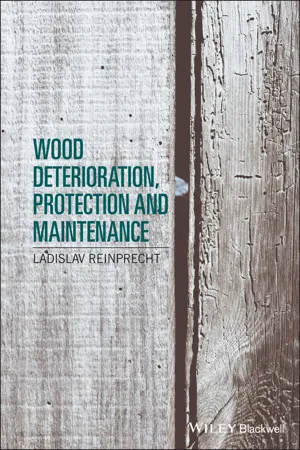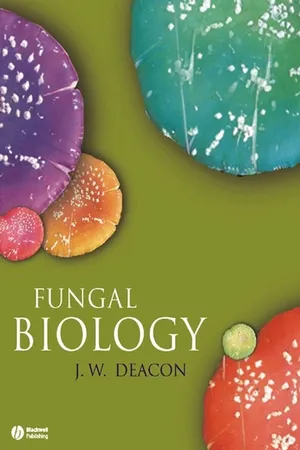Biological Sciences
Wood Fungus
Wood fungus refers to a type of fungus that primarily grows on wood and plays a crucial role in the decomposition of dead wood in forest ecosystems. These fungi break down the complex organic compounds present in wood, aiding in the recycling of nutrients back into the environment. Additionally, some wood fungi are also known for their ability to cause wood decay in structures and buildings.
Written by Perlego with AI-assistance
Related key terms
3 Key excerpts on "Wood Fungus"
- eBook - ePub
Fungi
Biology and Applications
- Kevin Kavanagh(Author)
- 2017(Publication Date)
- Wiley-Blackwell(Publisher)
Panaeolus papilionaceus is usually found on animal dung, where it is important in recycling the nutrients in the dung back into the environment. This chapter aims to highlight the diversity of fungi found in the environment and describe some of their ecosystem functions.In order to examine the fungi that provide these ecosystem functions, it is helpful to divide the fungi into three groups:- Symbiotic fungi form a close relationship with another nonfungal organism, in which both partners gain.
- Saprobic fungi break down debris (e.g. leaf litter and deadwood) and utilize the nutrients released.
- Parasitic fungi infect and take nutrition from another living organism.
While many of the examples in this chapter come from forest ecosystems (the author’s primary area of interest), the information and concepts are mostly applicable to other habitats too (e.g. grasslands). Furthermore, while the majority of known fungal species are microfungi, examples of macrofungi predominate in this chapter. This focus is partly one of preference of the author, but also because macrofungi have inherent characteristics that make them especially important for some ecosystem services, such as in food webs.13.2 Macrofungi, Mushrooms, and Sporocarps
The main component in terms of biomass in most fungi is the microscopic filaments (hyphae). While mushrooms are often the most noticeable part of the fungus, they only make up a small portion of the biomass of the fungal species. The majority of the fungus is growing in the substrate (e.g. soil, deadwood) in the form of a web of hyphae known as the fungal mycelium. In some species this mycelium can grow over many hundreds of meters in search for nutrients. When the mycelium encounters a food source, it releases a suite of powerful enzymes to break down the substrate and extract nutrients for the fungus. - eBook - ePub
- Ladislav Reinprecht(Author)
- 2016(Publication Date)
- Wiley-Blackwell(Publisher)
Wood – Decay, Pests and Protection. Chapman & Hall, London, UK, 546 pBacteria acting in wood damaged by other pests are living in symbiosis with fungi or insects. For example, during degradation of mine timbers or cooling tower slats, the wood polymers are decomposed first by enzymes of fungi to low molecule weight organic substances with a high content of carbon (glucose, xylose, etc.), and these subsequently become the food for bacteria. Fungi record this sensitively and adapt their metabolism to the current situation, that is, they will increase the production of 1,4-β-glucanases needed for depolymerization of cellulose.Antagonistic bacteria, such as B. subtilis, Bacillus asterosporus and other species, produce antibiotics and toxic or repellent substances to suppress the growth of fungi and other pests in wood (see Section 6.4).3.2 Wood damaged by fungi
Fungi are carbon-heterotrophic organisms without pigments for photosynthesis and without the ability to transform carbon dioxide (CO2 ) from air to organic substances. They for life must obtain carbon from other organic substrates; for example, wood-damaging fungi from wood.Wood-damaging fungi attack live or non-live wood (Gáper & Pišút 2003):- parasitic fungi act on live trees from which they draw nutrients and energy, and sometimes they even cause various disease in them;
- saprophytic fungi damage dead wood (e.g. wooden products);
- parasitic-saprophytic fungi primarily attack live trees, and saprophytic-parasitic fungi primarily attack non-live wood from which can be transformed on live trees.
Wood-damaging fungi cause failures in wood in various ways:- Wood-decaying fungi disrupt the structural components of wood (cellulose, hemicelluloses, lignin) and thus they also worsen its physical and mechanical properties. They cause extensive rot damages on live trees, logs, sawn timber and various products made of wood.
- eBook - ePub
- J. W. Deacon(Author)
- 2013(Publication Date)
- Wiley-Blackwell(Publisher)
Chapter 11
Fungal ecology: saprotrophs
This chapter is divided into the following major sections:- a theoretical model: the concept of life-history strategies
- the biochemical and molecular toolbox for fungal ecology
- a “universal” decomposition sequence
- the fungal community of composts
- fungal decomposers in the root zone
- fungal communities in decaying wood
The importance of fungi in ecosystem processes is undeniable. Fungi are the main agents of decomposition in many terrestrial and aquatic environments. They are particularly important in the breakdown and recycling of cellulose and hemicelluloses, which together account for nearly 70% of all the plant wall material that is recycled annually. In addition, fungi have a unique role in degrading woody substrates, which contain cellulose intimately complexed with lignin (lignocellulose). And, fungi degrade many other natural and manmade materials, causing serious economic losses.In previous chapters we dealt with the physiology, growth, genetics, and dispersal of fungi – the basis for understanding fungal ecology. But when we turn to fungi in natural environments we face a major problem, because natural communities are extremely complex: they contain many types of substrate, interacting species, and microhabitats. Therefore, at a practical level we need to find well-defined communities that can be dissected to provide key insights into fungal behavior. We will do this by focusing on a few natural “model” systems that have been well researched – the leaf zone, leaf litter, the root zone, self-heating composts, and wood decay. The principles derived from these natural model systems apply more generally across the fungal kingdom. We will also explore the biochemical and molecular toolbox that enables us to track and identify fungi in complex natural materials.A theoretical model: the concept of life-history strategies
Ecology lends itself to theoretical models as a basis for synthesizing complex information. The references at the end of this chapter cite some key publications in this field. Here we will briefly discuss one of these models, first developed by animal ecologists, then applied to plants and later to fungi – the concept of life-history strategies (Fig. 11.1
Learn about this page
Index pages curate the most relevant extracts from our library of academic textbooks. They’ve been created using an in-house natural language model (NLM), each adding context and meaning to key research topics.


